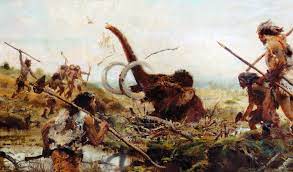Prehistoric Scotland

This is the time before written documentation. History is found, not in words but in Standing Stones, Geology, Archaeology. Our understanding of these early times is very basic, new revelations and theories are happening all the time so this is a history not set in stone, it’s one that is constantly changing.
Geologists (specifically geomorphologists) tell us that by 600 million years ago, it was attached to North America, and north of a land mass the would become England, which was attached to what would be mainland Europe. After much drifting over vast amounts of time, the two land masses collided. An ancient sea still separated the two lands called Iapetus. After this sea dried up the two lands joined, supposedly around where Hadrian’s wall is.
Scotland’s landscape formed by earthquakes and volcanic eruptions. Volcanoes along the Western side formed all the many islands.
The so-called “Highland Line” is actually a remnant of that turbulent period of land activity. Faults in the Earth’s surface would produce distinct structural divisions in the land that we now call Scotland. The Highland Boundary Fault Line was formed about 4 million years ago, from the splitting and folding of the Earth’s crust, and runs diagonally southwest (Firth of Clyde) to the northeast (Stonehaven).
Several ice ages pass.
Settlers came to Scotland several thousand years after the last Ice Age, but no one knows exactly whom the original people were. There are many theories about this. Man first inhabited north-western Europe 300,000 years ago we have yet to find anything older than 8500 BC (The oldest human settlement (yet found) in Scotland, is at Cramond, near Edinburgh) but who knows what new evidence will be unearthed.

|
The First Hunter GatherersAround 6,000 BC – 1,000 BC Currently our understanding is that around 8/10 thousand years ago the first people crossed the English channel from France during the last ice age when much of the world’s oceans were tied up in the ice sheets. Sea levels were so much lower that they could actually walk from France to England. These first people would have made their way up to Scotland. The last Ice Age was around twelve thousand years ago in Scotland and when it finished a dense forest covered much of Scotland.READ MORE |
 |
Neolithic Farmers and Monument BuildersThe Neolithic Age is considered the New Stone Age.By 3,000 BC. The population in Scotland increased partially due to the submerged land link between southeast England and Continental Europe — Britain had become an island. This forced some southern settlers to look for new lands in the north and the influx of people into Scotland began to alter the face of the land. People began to clear forests, farm and form permanent settlements such as the incredible Neolithic village of Skara Brae, in Orkney. READ MORE |
 |
Bronze AgeWith the advances that metal brought better weapons came and with this more warfare and the need to defend.In the Bronze Age period Brochs started to appear – around 1,000 BC. Protected from sea attacks. This was long before Vikings. This one we photographed on Shetland. This is The Broch of Mousa and is the best-preserved broch — still almost intact. Even centuries, after it ceased to function as designed, the Icelandic sagas say it was used on two occasions as a refuge for runaway lovers during Viking times. READ MORE |
 |
Iron Age – Celts, Picts and RomansCelts, more than simply one type of people is a common culture that spread to Scotland from Europe. Starting in Hungary through Austria, Switzerland and southern Germany into Britain and Scotland. It was a civilisation. This was a tribal, hierarchical and agricultural society. They held deep beliefs that we would find unacceptable today such as human sacrifices. They appreciated beauty and eroticism. It was a time of personal spiritual freedomREAD MORE |
